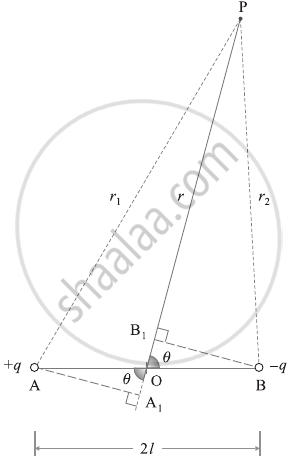Advertisements
Advertisements
Question
Derive an expression for the electric potential at a point due to a short electric dipole. Hence, write the expression for the electric potential at a point (i) dipole axis and (ii) on the dipole equator.
Solution
Think about an electric dipole AB with point charges + q and − q, and a dipole length of 2l. The magnitude of its electric dipole moment, `vecp`, is p = 2ql. As seen in the picture, P is a point located r away from O, the dipole's centre, in a direction θ perpendicular to the dipole axis. Assume BP = r2 and AP = r1.

Electric potential due to a short electric dipole
The electric potential at P due to the charge + q is
`V_1 = + 1/(4πε_0) q/r_1` ... (1)
and that due to the charge − q is
`V_2 = + 1/(4πε_0) q/r_2` ... (2)
Since the potential is a scalar quantity, the resultant electric potential at P due to the dipole is
V = V1 + V2
= `1/(4πε_0) q/r_1 - 1/(4πε_0) q/r_2`
= `q/(4πε_0) (1/r_1 - 1/r_2)` ... (3)
From Δ PAA1, by the cosine rule,
`r_1^2` = r2 + l2 + 2rl cos (180° − θ)
= `r^2 (1 + l^2/r^2 - 2 l/r cos θ)`
≃ `r^2 (1 - 2l/r cos θ)`
When `l^2/r^2` has been ignored because, for a short dipole (2l ≪ r), so that `l/r ≪ 1`.
∴ `r_1 = r (1 - 2 l/r cos θ)^(1/2)`
∴ `1/r_1 = 1/r (1 - 2 l/r cos θ)^(- 1/2) ≃ 1/r (1 + l/r cos θ)`
ignoring higher powers of `l/r` in the binomial expansion.
Similarly, `r_2^2 ≃ r^2 (1 + 2 l/r cos θ)`
∴ `r_2 = r (1 + 2 l/r cos θ)^(1/2)`
∴ `1/r_2 = 1/r (1 + 2 l/r cos θ)^(- 1/2) ≃ 1/r (1 - l/r cos θ)`
∴ `1/r_1 - 1/r_2 = 1/r ((2l)/r cos θ) = (2l)/r^2 cos θ` ... (4)
∴ From Eqs. (3) and (4).
V = `q/(4πε_0) ((2l cos θ)/r^2) = 1/(4πε_0). ((2ql)cos θ)/r^2` ... (5)
= `1/(4πε_0) (p cos θ)/r^2` ... (6)
This is the required expression.
(i) At a point on the dipole axis, θ 0° (nearer to the charge + q) or 180° (nearer to the charge − q).
∴ cos θ = ± 1
∴ Vaxis = `± 1/(4πε_0). p/r^2`
(ii) At a point on the dipole equator, θ 90° or 270° (equidistant from both the charges).
∴ cos θ = 0 ∴ Vequator = 0
